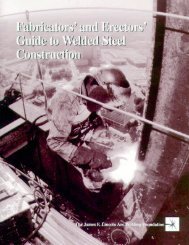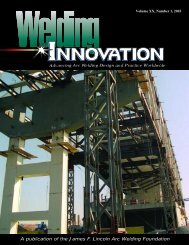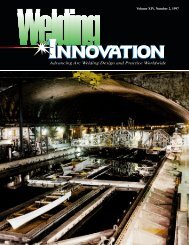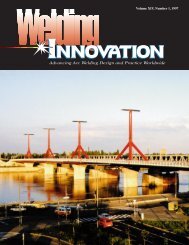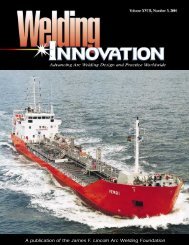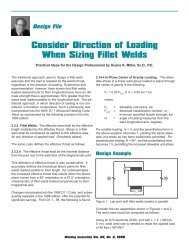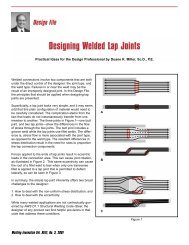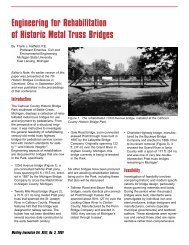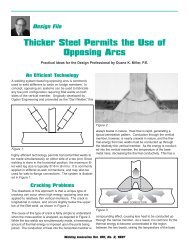A publication of the James F. Lincoln Arc Welding Foundation
A publication of the James F. Lincoln Arc Welding Foundation
A publication of the James F. Lincoln Arc Welding Foundation
You also want an ePaper? Increase the reach of your titles
YUMPU automatically turns print PDFs into web optimized ePapers that Google loves.
Orthotropic Design Meets Cold Wea<strong>the</strong>r Challenges<br />
An Overview <strong>of</strong> Orthotropic Steel Deck Bridges in Cold Regions<br />
By Alfred R. Mangus, P.E.<br />
Transportation Engineer, Civil<br />
California Dept. <strong>of</strong> Transportation (CALTRANS)<br />
Sacramento, California<br />
Introduction<br />
Initially developed by German engineers<br />
following World War II, orthotropic<br />
bridge design was a creative response<br />
to material shortages during <strong>the</strong> postwar<br />
period. Lightweight orthotropic steel<br />
bridge decks not only <strong>of</strong>fered excellent<br />
structural characteristics, but were also<br />
economical to build (Troitsky 1987).<br />
Moreover, <strong>the</strong>y could be built in cold<br />
climates at any time <strong>of</strong> <strong>the</strong> year.<br />
Engineers from around <strong>the</strong> world utilize<br />
this practical and economic system for<br />
all types <strong>of</strong> bridges. While concrete<br />
must be at or above 5 degrees Celsius<br />
to properly cure, it is physically possible<br />
to encapsulate and heat <strong>the</strong> concrete<br />
construction process; admittedly, this<br />
adds to construction costs (Mangus<br />
1988), (Mangus 1991).<br />
Orthotropic steel deck bridges have<br />
proven to be durable in cold regions.<br />
The orthotropic steel deck integrates<br />
<strong>the</strong> driving surface as part <strong>of</strong> <strong>the</strong><br />
superstructure, and has <strong>the</strong> lowest<br />
total mass <strong>of</strong> any practicable system.<br />
In Europe, where <strong>the</strong> advantages <strong>of</strong><br />
orthotropic design have been<br />
embraced with enthusiasm, <strong>the</strong>re are<br />
more than 1,000 orthotropic steel deck<br />
bridges. In all <strong>of</strong> North America, <strong>the</strong>re<br />
are fewer than 100 bridges <strong>of</strong><br />
orthotropic design.<br />
This article will give an overview <strong>of</strong><br />
imaginative steel deck bridges currently<br />
in operation in Norway, Russia,<br />
Sweden, and Ukraine. The examples<br />
Figure 1. Rib designs.<br />
cover a matrix <strong>of</strong> rib types, superstructure<br />
types and various bridge types.<br />
Russia has developed a mass manufactured<br />
panelized orthotropic deck<br />
system and has devised special<br />
launching methods for cold regions.<br />
Russian engineers prefer <strong>the</strong> open rib<br />
design and have industrialized this<br />
system, while most o<strong>the</strong>r engineers<br />
prefer <strong>the</strong> closed rib. Researchers, as<br />
well as <strong>the</strong> owners <strong>of</strong> orthotropic steel<br />
deck bridges, continue to monitor <strong>the</strong><br />
performance <strong>of</strong> various rib types<br />
(Figure 1).<br />
In Norway<br />
Nordhordland Floating Bridge<br />
The Nordhordland Bridge across <strong>the</strong><br />
Salhus fjord is Norway’s second floating<br />
bridge and <strong>the</strong> world’s largest floating<br />
bridge (Meaas, Lande, and Vindoy,<br />
1994). The bridge was opened for traffic<br />
in 1994. The total bridge length is<br />
1615 m and consists <strong>of</strong> a high level<br />
369 m long cable stayed bridge and a<br />
1246 m long floating bridge (Figure 2).<br />
The floating bridge consists <strong>of</strong> a steel<br />
box girder, which is supported on ten<br />
concrete pontoons and connected to<br />
abutments with transition elements in<br />
forged steel. The main elements are a<br />
high-level cable stayed bridge providing<br />
a ship channel and a floating<br />
bridge between <strong>the</strong> underwater rock<br />
Klauvaskallen and <strong>the</strong> o<strong>the</strong>r side <strong>of</strong><br />
<strong>the</strong> fjord. The cable stayed bridge provides<br />
a clear ship channel. A 350 m<br />
long ramp is required to transition from<br />
<strong>the</strong> higher bridge deck on <strong>the</strong> cable<br />
2 <strong>Welding</strong> Innovation Vol. XIX, No. 1, 2002<br />
Figure 2. Nordhordland Floating Bridge across Salhus fjord <strong>of</strong> Norway.



